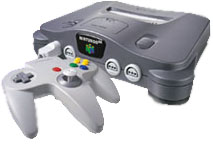
|
In 1985, the Nintendo Entertainment System revolutionized
and revitalized the Video Game industry. That means Nintendo
has only itself to blame for its current competition.
Add to this the fact that Nintendo's deal with Sony to develop
a CD-ROM expansion to the SNES collapsed, and Sony transformed
the salvage into the Sony Playstation. |
The Video Gaming market is split primarily between three contenders:
The Nintendo 64, the Sony Playstation, and the PC market. Each
has its own advantages. The PC gaming platform, while comparatively
expensive, has the potential for superior graphics and internet
play. The Sony Playstation has large storage media and widespread
developer support, but its slow CD-ROM drive can create annoying
load times, and the Playstation has some minor quirks, like no
hardware filters and some issues with twitching textures.
The Nintendo 64, released over a year after the Playstation,
still has fewer games, most likely due to their choice of the
limited size cartridge media, but load times are non-existent.
Antialiasing and fog effects are built into the hardware, and
Nintendo's few developers are top notch, with Nintendo itself
and second and third-party companies like Rare, Iguana, and Left
Field Studios putting out extraordinary games like Turok 2, Goldeneye
007, NBA Courtside, and The Legend of Zelda: The Ocarina of Time.
The latter has been acclaimed by many as the best video game
ever made, for its expansive cinematic locations and breathtaking
special effects. Many, however, prefer the Final Fantasy saga,
previously for the Nintendo and Super Nintendo, and now appearing
on the Playstation, for its pre-rendered cinema and enormous
storyline, which consumed three full CD's.
Further complicating the industry will be the release of the
Sega Dreamcast this summer. Sega has a tradition of releasing
a powerful system early in a generation, then falling behind
newer technology with poor quality games. The Dreamcast may be
another example of this effect, as Sony has recently announced
its "Playstation 2", which will be over 3 times as
powerful as the Dreamcast when it is released in at least a year.
For this round, however, Sega says that they will provide much
more support for third party developers. Since the extinction
of the Saturn, Sega has been surviving based on the revenue from
its arcade games such as Gunblade and House of the Dead. The
Dreamcast, already released in Japan, features astounding visuals
but sales have been disappointing, as the system has not been
performing as well as the Nintendo 64 in the techno-savvy Japanese
market.
The Nintendo 64 has in the past performed poorly in Japan,
due primarily to the Cartridge media used and the lack of developer
support. In recent months, however, titles like The Legend of
Zelda, Mario Party, and Super Smash Brothers have attracted niche
gamers back to the console. Nintendo owes much of their global
success to one man, Shigeru Miyamoto, who developed the Super
Mario 64, F-Zero X, and The Legend of Zelda. (It is often pointed
out that the Nintendo
64 was primarily developed to showcase Mario 64.)
Nintendo also has an ace up its sleeve, with its new, yet-unnamed
console, arriving in at least two years. The system will definitely
not use cartridges, instead probably leaning toward the much
larger DVD format. Don't expect much news on this system for
a while, though.
Meanwhile, in the handheld market, the Nintendo Game Boy has
enjoyed dominance for over a decade. When it was introduced in
1989, it faced stiff competition from both the Sega Game Gear,
a color handheld system which was restrictively large and had
short battery life; and the Atari Lynx, a technologically superior
system, also with color, but with very little software support.
Both systems eventually fell by the wayside (The Lynx first)
as consumers chose the smaller greenish-monochrome system with
the longer battery life and the developer support. (The Game
Boy, and Game boy Software, consistently outsell Nintendo 64
hardware and software in Japan.) In 1998, the Game Boy Color
was released, approximately doubling the power of the original
system and adding color, force-feedback, and infra-red capabilities
to the original system.
At the top of the power spectrum is the Gaming PC, which has
the advantage of being fully scalable, but the disadvantage of
an unenviably high price. 3D accelerators such as the 3dfx Voodoo
and the Nvidia Riva TNT allow the computer to achieve realistic
3D graphics in real time--but these cards can cost $200 or more
each, in addition to the over $1,000 price tag of the PC.
Add to that as much as $60 for a gaming mouse, or $100 or
more for a high quality joystick, and your gaming PC can run
you quite a pretty penny. However, as many a hardcore gamer will
agree, it's the only way to play games with people around the
world. (This may change--the Dreamcast is shipping with a 56k
modem)
With three new game consoles and several new 3D accelerators
hitting the market in the next few years, it is clear the video
game industry will not be collapsing anytime soon. Students interested
in breaking into the industry should look into Full Sail or Digipen,
two colleges which offer courses specializing in video game production.
Whatever your favorite genre, though, at least one company is
sure to be making a game for you.
Image credits: Nintendo 64, copyright 1997 Nintendo. Dreamcast
image from IGNDC; copyright 1998 Sega. Game Boy Color, copyright
1998 Nintendo. Drakan:Order of the Flame, copyright 1999 Surreal
Software/Psygnosis. |